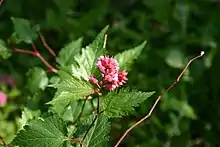| Neillia | |
|---|---|
 | |
| Neillia sinensis | |
| Scientific classification | |
| Kingdom: | Plantae |
| Clade: | Tracheophytes |
| Clade: | Angiosperms |
| Clade: | Eudicots |
| Clade: | Rosids |
| Order: | Rosales |
| Family: | Rosaceae |
| Subfamily: | Amygdaloideae |
| Tribe: | Neillieae |
| Genus: | Neillia D.Don |
| Species | |
|
See text | |
| Synonyms | |
|
Stephanandra Siebold & Zucc. | |
Neillia is a genus of the botanical family Rosaceae. They are deciduous shrubs or subshrubs. They produce clusters of terminal or axillary flowers, and have dry dehiscent fruits.[1] They are native to eastern and central Asia.[2]
This genus is named for Patrick Neill.[3]
Species
.jpg.webp)
Flowers of the Neillia affinis species
This genus contains around fifteen to seventeen species.[2][4] Recent phylogenetic analysis has shown that the genus Stephanandra is embedded in Neillia, and is perhaps the evolutionary result of hybridization within Neillia lineages. Because of this, the former members of Stephanandra are included in this classification.[1][5]
The species of Neillia are:
- Neillia affinis
- Neillia breviracemosa
- Neillia densiflora
- Neillia fugongensis
- Neillia gracilis
- Neillia grandiflora
- Neillia incisa – lace shrub
- Neillia jianggangshanensis
- Neillia ribesioides
- Neillia rubiflora
- Neillia serratisepala
- Neillia sinensis
- Neillia sparsiflora
- Neillia tanakae
- Neillia thibetica
- Neillia thrysiflora
- Neillia uekii
References
- 1 2 Neillia Flora of North America
- 1 2 Neillia Flora of China
- ↑ . Dictionary of National Biography. London: Smith, Elder & Co. 1885–1900.
- ↑ Neillia Kew Botanical Gardens
- ↑ D. Potter; T. Eriksson; R. C. Evans; S. Oh; J. E. E. Smedmark; D. R. Morgan; M. Kerr; K. R. Robertson; M. Arsenault; T. A. Dickinson & C. S. Campbell (2007). "Phylogeny and classification of Rosaceae" (PDF). Plant Systematics and Evolution. 266 (1–2): 5–43. doi:10.1007/s00606-007-0539-9. S2CID 16578516. Note that this publication pre-dates the 2011 International Botanical Congress which mandates that the combined subfamily referred to in the paper as Spiraeoideae must be called Amygdaloideae.
This article is issued from Wikipedia. The text is licensed under Creative Commons - Attribution - Sharealike. Additional terms may apply for the media files.